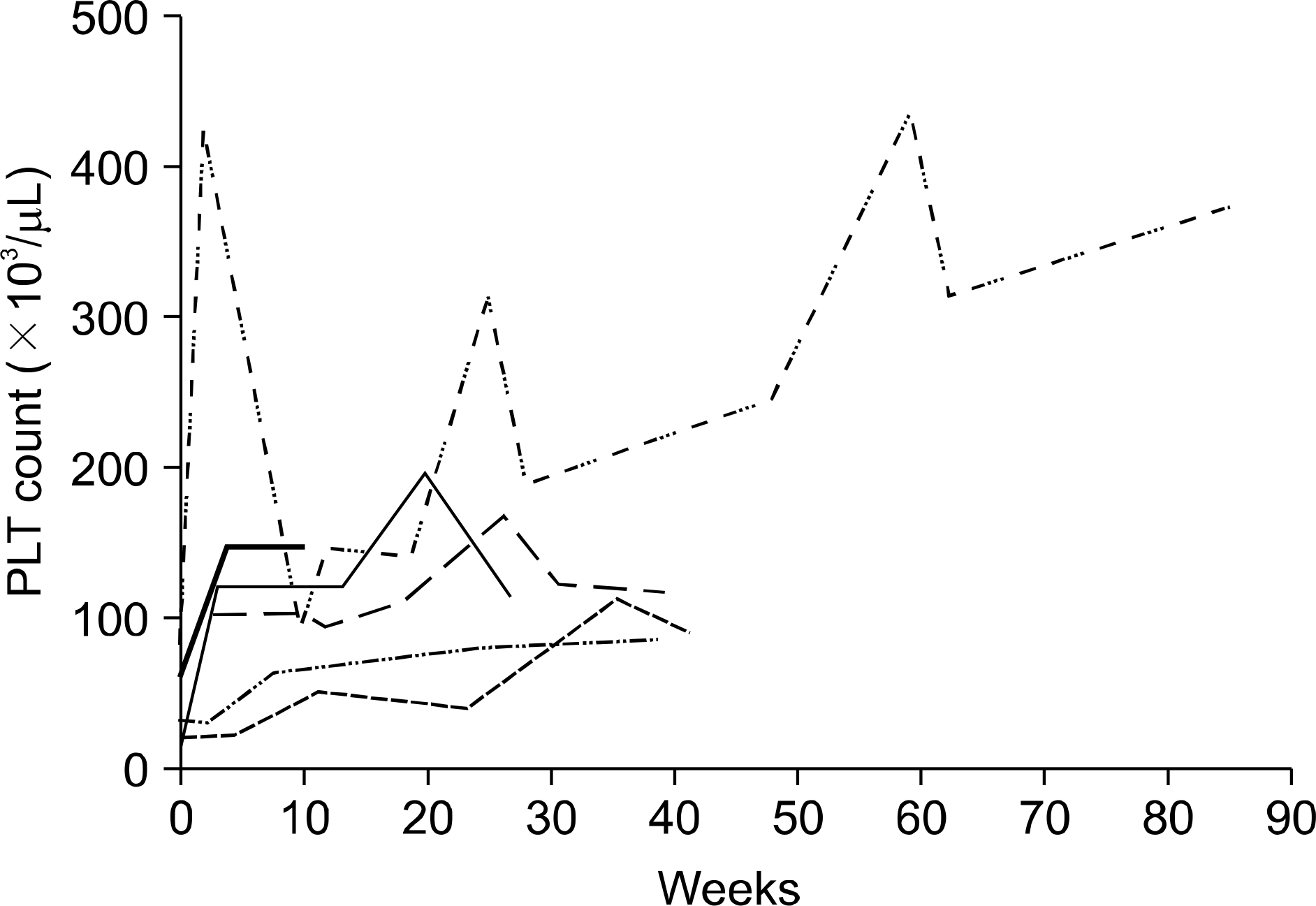Abstract
Background
Helicobacter pylori (H. pylori) have been implicated in the pathogenesis of some autoimmune diseases including idiopathic thrombocytopenic purpura (ITP). Several studies have recently shown a high prevalence of H. pylori infection in patients with ITP, and reported platelet recovery after bacterial eradication therapy. The prevalence of H. pylori infection, and the effect of its eradication, in Korean patients with chronic ITP were investigated.
Methods
The study included 35 patients, from 8 hospitals, with chronic ITP. The H. pylori infection was assessed by the urea breath test, rapid urease test or microbial culture. H. pylori eradication was performed with the amoxicillin, clarithromycin and omeprazole regimen for 7 days, or the bismuth, metronidazole and tetracycline regimen for 10 days. Eradication was assessed by urea breath test 4 weeks
Results
Thirty five patients with chronic ITP were evaluated, including 12 males and 23 females, with a median age of 57 years (range 30~79). The median platelet count before eradication was 23,000/μL (range 4,000~66,000/μL). Sixteen patients had previously undergone a splenectomy. The H. pylori infection was found in 23 (65%) of the 35 patients. Eradication, was performed in 21 patients, and 6 (28.5%) had a significant increase in their platelet counts after both 2 weeks and 2 months. The median response duration was 7.6 months, ranging from 1~27 months.
Go to : 
REFERENCES
1). Marshall BJ, Armstrong JA, McGechie DB, Glancy RJ. Attempt to fulfil Koch's postulates for pyloric Campylobacter. Med J Aust. 1985; 142:436–9.

2). Forman D, Newell DG, Fullerton F, et al. Association between infection with Helicobacter pylori and risk of gastric cancer: evidence from a prospective investigation. BMJ. 1991; 302:1302–5.

3). Claeys D, Faller G, Appelmelk BJ, Negrini R, Kirchner T. The gastric H+, K+-ATPase is a major autoantigen in chronic Helicobacter pylori gastritis with body mucosa atrophy. Gastroenterology. 1998; 115:340–7.
4). Figura N, Giordano N, Burroni D, et al. Sjögren's syndrome and Helicobacter pylori infection. Eur J Gastroenterol Hepatol. 1994; 6:321–2.
5). Reinauer S, Megahed M, Goerz G, et al. Schönlein-Henoch purpura associated with gastric Helicobacter pylori infection. J Am Acad Dermatol. 1995; 33:876–9.

6). Zentilin P, Savarino V, Garnero A, Accardo S, Seriolo B. Is Helicobacter pylori infection a risk factor for disease severity in rheumatoid arthritis? Gastroenterology. 1999; 116:503–4.

7). de Luis DA, Varela C, de La Calle H, et al. Helicobacter pylori infection is markedly increased in patients with autoimmune atrophic thyroiditis. J Clin Gastroenterol. 1998; 26:259–63.

8). Gasbarrini A, Franceschi F. Autoimmune diseases and Helicobacter pylori infection. Biomed Pharmacother. 1999; 53:223–6.

9). Gasbarrini A, Franceschi F, Tartaglione R, Landolfi R, Pola P, Gasbarrini G. Regression of autoimmune thrombocytopenia after eradication of Helicobacter pylori. Lancet. 1998; 352:878.

10). Emilia G, Longo G, Luppi M, et al. Helicobacter pylori eradication can induce platelet recovery in idiopathic thrombocytopenic purpura. Blood. 2001; 97:812–4.

11). Hashino S, Mori A, Suzuki S, et al. Platelet recovery in patients with idiopathic thrombocytopenic purpura after eradication of Helicobacter pylori. Int J Hematol. 2003; 77:188–91.

12). Kohda K, Kuga T, Kogawa K, et al. Effect of Helicobacter pylori eradication on platelet recovery in Japanese patients with chronic idiopathic thrombocytopenic purpura and secondary autoimmune thrombocytopenic purpura. Br J Haematol. 2002; 118:584–8.

13). Hino M, Yamane T, Park K, et al. Platelet recovery after eradication of Helicobacter pylori in patients with idiopathic thrombocytopenic purpura. Ann Hematol. 2003; 82:30–2.

14). Veneri D, Franchini M, Gottardi M, et al. Efficacy of Helicobacter pylori eradication in raising platelet count in adult patients with idiopathic thrombocytopenic purpura. Haematologica. 2002; 87:1177–9.
15). Choi DS, Seo YT, Choi SH, Kim HJ, Kim BS. Resolution of chronic idiopathic thrombocytopenic purpura after eradication of Helicobactor pylori: a case report. Korean J Hematol. 2003; 38:270–3.
16). George JN, Woolf SH, Raskob GE, et al. Idiopathic thrombocytopenic purpura: a practice guideline developed by explicit methods for the American Society of Hematology. Blood. 1996; 88:3–40.
17). Jarque I, Andreu R, Llopis I, et al. Absence of platelet response after eradication of Helicobacter pylori infection in patients with chronic idiopathic thrombocytopenic purpura. Br J Haematol. 2001; 115:1002–3.

18). Michel M, Cooper N, Jean C, Frissora , Bussel JB. Does Helicobactor pylori initiate or perpetuate immune thrombocytopenic purpura? Blood. 2004; 103:890–6.
19). Kim JH, Kim HY, Kim NY, et al. Seroprevalence of Helicobactor pylori infection in asymptomatic people in Korea. Korean J Med. 2000; 59:388–97.
20). Takahashi T, Yujiri T, Shinohara K, et al. Molecular mimicry by Helicobactor pylori CagA protein may be involved in the pathogenesis of H. pylori-associated chronic idiopathic thrombocytopenic purpura. Br J Haematol. 2004; 124:91–6.
21). Evans DJ Jr, Evans DG. Helicobactor pylori CagA: analysis of sequence diversity in relation to phosphorylation motifs and implications for the role of CagA as a virulence factor. Helicobactor. 2001; 6:187–98.
22). McCrae KR. Helicobactor pylori and ITP: many questions, few answers. Blood. 2004; 103:752–3.
23). Takahashi T, Yujiri T, Tanizawa Y. Helicobactor pylori and chronic ITP: the discrepancy in the clinical responses to eradication therapy might be due to differences in the bacterial strains. Blood. 2004; 104:594.
Go to : 
 | Fig. 1.Courses of platelet counts in responsive patients after eradication. Day 0 indicates the first day of initial eradication treatment. |
Table 1.
Patients characteristics
| Total number of patients | 35 |
| Sex (male/female) | 12/23 |
| Age (range/median, years) | 30~79/57 |
| H. pylori infectivity | |
| (+) | 23 |
| (-) | 12 |
| Platelet count (range/median, μL) | 4,000~66,000/23,000 |
| No of previous treatment | |
| 0 | 3 |
| 1 | 9 |
| 2 | 8 |
| ≥3 | 15 |
| Splenectomy | 16 |
| Eradication regimen | |
| CAO∗ | 13 |
| BMT† | 8 |
| Time from diagnosis to eraddication (range/median, years) | 0.6~19/2.6 |




 PDF
PDF ePub
ePub Citation
Citation Print
Print


 XML Download
XML Download